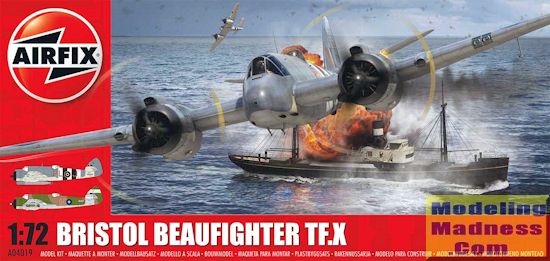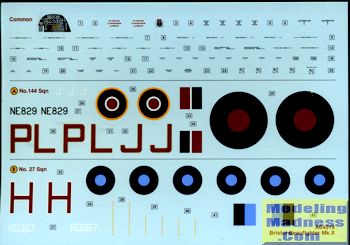
Airfix 1/72 Beaufighter TF.X
| KIT #: | A04019 |
| PRICE: | $19.99 SRP |
| DECALS: | Two options |
| REVIEWER: | Scott Van Aken |
| NOTES: | New tool kit |

| HISTORY |
The Bristol Type 156 Beaufighter (often referred to simply as the "Beau") is a multi-role aircraft developed during the Second World War by Bristol Aeroplane Company in the UK. It was originally conceived as a heavy fighter variant of the Bristol Beaufort bomber. The Beaufighter was a versatile aircraft used in service initially as a night fighter, and later mainly in the maritime strike and ground attack roles; it also replaced the earlier Beaufort as a torpedo bomber.
Variants built in Australia by the Department of Aircraft Production (DAP) were sometimes referred to by the name DAP Beaufighter.
| THE KIT |
 This
is another 'replacement' kit as Hornby continues to upgrade the old Airfix
catalogue. This is, like the previous kit, also a TF.X, though not the version
with the dorsal extension. Since the TF.X was the last and most numerous of the
Beaufighter variants, it is logical that this would be the one kitted. I'm not
sure when this variant entered production, but I'd hazard that it was only in
the last year or so of the war.
This
is another 'replacement' kit as Hornby continues to upgrade the old Airfix
catalogue. This is, like the previous kit, also a TF.X, though not the version
with the dorsal extension. Since the TF.X was the last and most numerous of the
Beaufighter variants, it is logical that this would be the one kitted. I'm not
sure when this variant entered production, but I'd hazard that it was only in
the last year or so of the war.
The kit is a bit different from how we'd expect it to have been engineered. It starts by having you assemble the two wing spars onto the cockpit/gunner's floor. To this one adds the various seats and controls. Crew members are provided should you wish them. To the front of the two partial fuselage halves, one attaches the pilot's side consoles and in the back the tail wheel. As the kit can be assembled gear up, two tail wheel pieces are provided.
One then places the assembled fuselage onto the floor/wing spar section. To the underside of the fuselage, one then installs the lower fuselage piece, after opening the holes for the torpedo if that is to be modeled. When it comes to the wings, one will need to open holes for the rockets if those are chosen. The Beaufighter carried one or the other, never both as that would have exceeded the weight limits. A small fairing on the upper wing will need to be removed before gluing the wings together. Separate ailerons are provided.
In the back there are two styles of horizontal stabilizer, one with larger elevators. Instructions state which option fits which scheme. Due to the near one-piece horizontal stab, the fin and rudder are separate and fit atop it when it is installed.
Moving to the front, there is a short nose cap and the two engine assemblies to install. The engine cowling is five pieces with three to surround the engine and two pieces for the forward section. A two piece 'hedgehog' exhaust is then installed. The carb intakes are two pieces with a separate forward section.
Wheels are three pieces with two tire halves and a separate hub. Lainging gear are nicely molded and properly sturdy looking. You'll undoubtedly scrape paint from the wheels when installing them as that happens (at least to me) with all landing gear like this. Weapons installation is next, again, the instructions indicating which scheme uses which. The kit has two styles of landing light cover and these are annotated as to which markings option uses them.
Other bits to attach are intake faces, wing tip light lenses, a scoop in front of the windscreen, pitot tube, rear gun and the clear bits. The props are so designed to press into the engine fronts after they are built up.
Instructions are well drawn and offer only Humbrol
paint numbers until one gets to the overall scheme. The torpedo plane is the box
art plane in extra dark sea grey over 'b eige-green'
with invasion stripes over the rear fuselage. This is from 144 Squadron in late
1944. The other is a SEA plane from 27 Squadron in August 1945. It is in dark
green/dark earth over medium sea grey with white bands around the flying
surfaces. I noticed that the instructions would have you paint the exhaust
collectors on the front of the engine cowling in black rather than a burnt
metal. Decals are nicely done and stripes will need to be painted. Airfix
tells you the width of these stripes to help you keep them straight.
eige-green'
with invasion stripes over the rear fuselage. This is from 144 Squadron in late
1944. The other is a SEA plane from 27 Squadron in August 1945. It is in dark
green/dark earth over medium sea grey with white bands around the flying
surfaces. I noticed that the instructions would have you paint the exhaust
collectors on the front of the engine cowling in black rather than a burnt
metal. Decals are nicely done and stripes will need to be painted. Airfix
tells you the width of these stripes to help you keep them straight.
| CONCLUSIONS |
Overall a very nice looking kit. While it hasn't gotten the buzz as some of the other new releases (just in time for Christmas), I'm sure it will make into an excellent model. One can only hope that it sells well enough for Airfix to do other variants.
| REFERENCES |
https://en.wikipedia.org/wiki/Bristol_Beaufighter
Copyright ModelingMadness.com October 2015 Thanks to me for picking this up. If you would like your product reviewed fairly and fairly quickly, please contact the editor or see other details in the
Note to
Contributors.